October 16, 2025 • 5 min read
The New AI For CX Trends To Watch In 2026

CX Analyst & Thought Leader
October 16, 2025

Customer experience moves fast: trends change, different software debuts, and there's always a new "CX buzzword" to learn. But as anyone in the space knows, lately things have been moving at warp speed (thanks, AI.) This means that 2025's hottest CX tools and strategies are already veering on outdated.
So, what's new for 2026?
- Superpower virtual agents that autonomously resolve customer issues across voice and digital channels
- AI-first (but never AI-only) customer service
- Moving from AI integration to AI orchestration
- Next-level AI model monitoring and governance with data observability
Companies that start anticipating these 2026 CX and AI trends now will be the ones on top.
1. Voice AI
The days of IVRs (those irritating “press 1 for accounting” automated phone menus) are over: Voice AI is here to stay.
Digital channels are rising in popularity largely because of repeated inefficient, low-quality phone support. Customers cite frustration with long hold times, unhelpful or confusing auto attendants, uninformed agents, and (especially thanks to the rise of digital agents) the inability to connect with a “real person” when needed.
Voice AI agents, powered by Agentic AI, can autonomously resolve customer phone queries. But more importantly, voice AI agents can have natural, conversational, and two-way phone conversations with customers in real time. They can analyze customer sentiment and intent, access all integrated customer data and conversation histories, and can even transfer callers to a live agent if needed.
Voice AI meets customer demand for better and faster phone support without driving up operating costs or overburdening agents. And if you’re worried customers won’t want to “talk to a robot,” think again: 60% of customers want companies to adopt Voice AI, and nearly 70% say their experience would be improved by more natural-sounding voicebots.*]
2. AI-First Customer Service
AI builds consumer trust and improves CX because it empowers companies to provide quick, hyper-personalized suggestions and resolutions. In 2026, a proactive, omnichannel, AI-first approach to customer service will become the norm. Gartner predicts that 80% of routine customer service interactions will be entirely resolved with AI, leading to a 30% reduction in operating costs.[*] Note, however, that AI-first does not mean AI-only. Brands that balance automation with the human touch, as well as those that nail the AI-to-human handoff in customer interactions, will take the CX lead.
The AI-first approach doesn’t just optimize the customer experience. In 2026, will catapult the use of AI for EX (employee experience) into the mainstream.
As employees continue to experience the benefits of AI firsthand–especially the automation of time-consuming, low-value, and monotonous tasks–their lack of trust in AI will continue to decline. AI will be seen as an essential employee experience (and workforce optimization) tool in 2026 and beyond. Companies using AI see a 5.5x YOY increase in employee engagement, with the biggest benefits coming from real-time agent guidance via Agent Assist.
3. From GenAI LLMs to Agentic AI LAMs
GenAI may have been all the rage in the first half of 2025, but now the business world can’t stop talking about the next big thing: Agentic AI. GenAI tools, like ChatGPT, are powered by general-purpose LLMs (Large Language Models) trained on massive amounts of data. While GenAI is ideal for summaries, content creation, and translation; hallucinations and a lack of niche expertise remain common problems.

Enter Agentic AI, powered by LAMs (Large Action Models.) Unlike LLMs, which are more informational in nature, LAMs are operational. Agentic AI, powered by LAMs, evaluates current and historical context, determines the best course of action based on the desired outcome, then autonomously takes action to provide a resolution.
While LLMs can think and talk, LLMs can think, talk, and execute–meaning the chatbot era will soon give way to the age of smart digital assistants. Currently, nearly 30% of global businesses already use virtual agents powered by Agentic AI, while 44% plan to deploy these autonomous agents in 2026.[*]
4. AI Orchestration
Although AI-powered omnichannel solutions have certainly reduced business tech stacks, ⅓ of organizations still use five or more different CX applications.[*] While software integrations enable data synching and omnichannel communication, businesses are quickly realizing they don’t go far enough. That’s why many companies will focus on developing and deploying an AI orchestration policy in 2026.
What is AI orchestration?
AI orchestration is the technical process of unifying all of a business’s AI tools, models, systems, and workflows into one overarching AI system. The goal is to ensure everything in your tech stack is working together to achieve a greater goal or accomplish a singular task. But unlike simple integration, orchestration coordinates workflow automations between all your AI tools without human intervention. The resulting orchestration facilitates the kinds of high-level, completely autonomous actions that would completely overwhelm a single AI app or model.
For more information, check out our above series on AI Orchestration.
5. Data Observability
Conversational analytics–the use of AI to glean next-level insights like sentiment, emotion, and intent analysis from 100% of natural language customer conversations–reigned supreme in 2025.
But in 2026, businesses will refocus their efforts on data observability: the process of making sure all the data they collect and act on is accurate, unbiased, reliable, and complete across its lifecycle. Data observability tools monitor how your data is used in AI models, identifying its traceability, consistencies, and anomalies.
Data observability prevents businesses from making major changes based on outdated data. It helps provide a familiar customer experience that consistently meets expectations and evolves alongside demand.
Getting Ahead of The 2026 CX Trends
If you plan to actually move from the experimentation to implementation phase in 2026, the time to start ideating and prepping for next year's CX trends is now.
Which of these is your business the most excited about? Which ones did we miss?